Leveling Up with Eric Siu
A Look Inside the Data Focused Growth Model of SaaSOptics with Tim McCormick, CEO (podcast)
When it comes down to it, SaaS businesses are valued on their ARR, but surprisingly, some still choose to manage the metrics and analytics that come as a byproduct of their order to cash process themselves. What they need is a platform, because having a single source of truth that drives all these metrics can’t be understated. Today’s guest is Tim McCormick, CEO of SaaSOptics, a platform that provides this very service. Specifically, SaaSOptics is a subscription management platform that provides early-stage and growth SaaS businesses with subscription billing, revenue recognition, financial reporting, and robust SaaS analytics. In our conversation with Tim today, we get into his career in tech running SaaS businesses in the security and energy management space, and the multiple exits he has orchestrated. He then dives into what SaaSOptics does and how they run their business to keep seeing such big growth. He gets into how SaasOptics automates the order to cash process, effectively sitting between the CRM and the general ledger. Tim talks about the metrics SaasOptics provides, their value-based pricing model, and how they balance marketing and sales in order to grow. We hear about the structure of their sales team, and their model of product cycles based on market changes too. There are around 30 000 B2B SaaS businesses globally thus the services SaaSOptics provides can’t come at a better time, so tune in to find out what it’s all about!
TIME-STAMPED SHOW NOTES:

Resources From The Interview:
Leave Some Feedback:
Connect with Eric Siu:

This post originally appeared on Single Grain, a growth marketing agency focused on scaling customer acquisition.
Research shows that the average person gets 147 e-mails a day — and most of them are a pain to receive.
In fact, based on Baydin Boomerang e-mail research, we delete 71 e-mails in an average time of under 3.2 seconds each. That’s all the time you have to get a prospect to give you their attention, understand your message, and follow through on your call to action.
But the problem is, most cold e-mails are terrible. The senders don’t follow up (44% of salespeople don’t), they write bad subject lines that have readers heading for the delete button before they’ve even opened it, they start the e-mail off with a templated message that sounds inauthentic, they pepper them with links, or they don’t focus on what’s in it for the reader.
Is it any wonder that most salespeople struggle to get a response rate of 10%?
For example, according to CB Insights, most terrible cold e-mails start with a generic “congrats on your funding” or “it seems like you’re growing” message which aren’t tailored to the reader.
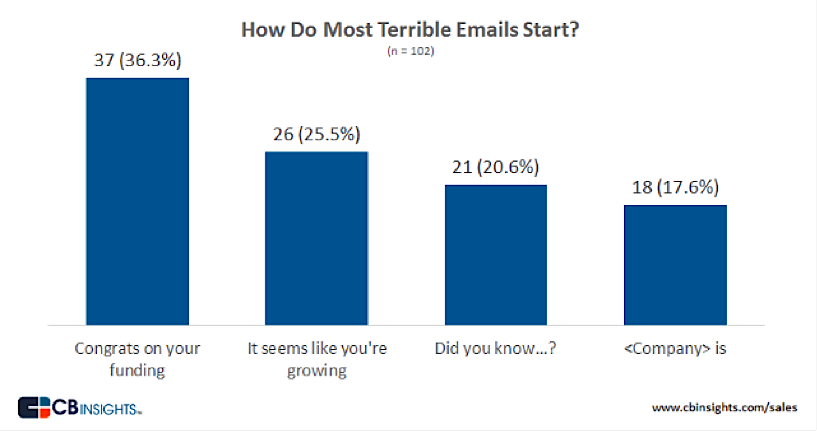
But those who do cold e-mails right can see incredible results in record time — like this company that got a 57% open rate, 21% response rate, and 16 new B2B customers from a few simple e-mail tweaks.
Even though many of us are drowning in e-mail and would like to see less of it, e-mail is still the number one platform for generating sales. No other platform has conditioned us to expect messages from complete strangers and actually respond as well as e-mail has.
In this post, I’ll talk about some strategies and tactics you can use to skyrocket your response rates to your cold emails.
But before you start writing cold emails, it’s important to get inside the mind of your target audience.
Many salespeople dive right into subject line and e-mail marketing tactics without taking the time to really get inside the minds of their customers first. They immediately focus on blasting out a huge volume of e-mails, hoping that a few people will somehow respond.
This is the main reason why most cold e-mails come off as spammy and are instantly deleted.
Check out this sample of a bad cold e-mail that Jill Kornath received (sometimes it’s also good to know what not to do):
[Your Name]
My name is Jennifer with XYZ Sales Training. We improve sales performance through our unique blend of sales technology and experience, resulting in 89% better quota achievement. Our industry-leading methodology has helped more than 650,000 sales professionals find and close more deals, and our proven sales process makes your forecast and pipelines accurate by putting science behind it.
It all gets delivered through our BigDeal® technology – the on-demand Sales Performance Automation application that operates standalone, or can be integrated with your existing CRM system to produced sustained, measurable results. And to ensure that your sales teams get the full benefit, our virtual learning system delivers on-the-job training worldwide – reinforced by expert coaching.
I am not sure if you would be the appropriate contact, but I am trying to find the person at your organization who evaluates our type of program offering. Would it be possible for us to speak for 5 minutes or can you point me to the correct person to contact? Find out how organizations like Microsoft, Xerox, Honeywell, Siemens, United Healthcare and Adobe have found success with our offering and how [not provided] can find similar achievement.
Thank you in advance for any assistance you can provide. I kindly await your response!
E-mails like the one above aren’t just low converting — they also don’t show any empathy for the reader. And if you don’t focus on what’s in it for the reader, they’ll lose interest pretty fast.
Here are a few key things to remember about the psychology of readers before sending an e-mail:
Many cold e-mails fall flat because they don’t take into account the fact that they’re selling to individuals first, not corporations.
Sometimes we forget that the person at the other end of the e-mail is also just like us — with the same range of emotions, hopes and fears. It might seem like we’re selling to companies that make logical, formal decisions about what products they buy, but in reality those decisions are heavily influenced by the emotions of the people making those decisions.
It’s a well known fact: people buy with emotion, then justify afterward with logic. The same thing applies to cold e-mails.
For example, you could include in the e-mail why it would benefit them personally to purchase your product. Maybe they want to feel important in meetings. Maybe they want their boss to recognize them more. Maybe they want to improve their performance so they can get a raise.
HubSpot gives a few really good examples of ways to start off this type of message: you could say something like “here’s how this is going to make you look like a hero to your team” or “here’s how it’s going to make your team more productive and generate more revenue.”
E-mails like this set themselves apart from the crowd because they show empathy, they show that you really took some time to think about what the person reading the e-mail would actually want instead of blasting a thousand different leads with the same template.
Anand Sanwal, the CEO of CB Insights, said that he would be willing to look at whitepapers, case studies, and consider a product that was relevant to his company’s situation in this writeup.
However, most emails didn’t even specifically mention what was in it for him, so he went straight for the delete button like so many others.
Learn More: 5 Ways Cold Emailing Can Help Generate Backlinks
Whenever we send out an e-mail asking people to sign up for a demo or get on a sales call, it’s usually at the center of our attention. It’s one of the most important things we focus on all day. But to the average prospect, your e-mail is just a small little blip in their day. They have other, pressing problems to worry about.
As Jill Kornath says: Let’s say you’re the VP of sales for your company. You’re swamped and have to deal with a million different problems at work all at once. Maybe one of your top customers is upset with something. Maybe you’ve had some turnover. Maybe you have an overflowing inbox and you just happened to click on someone’s cold e-mail.
What sort of message would make you want to respond and get on a call with the salesperson?
It’s important to understand the workflow that your prospects go through in a typical day and try to make your e-mail fit within that workflow. For a prospect who’s having a tough day, a bad cold e-mail could make them even more agitated.
But a good e-mail will help you earn their respect, which would likely lead to a response. Like it or not, you’re also being judged by your prospects on your ability to sell, not just what you’re selling.
Next, we’ll dive into some tactics on how to get more responses from your cold e-mails.
Once you send the e-mail, there’s only one thing that determines whether your prospect will actually read it or not: your subject line.
If you get that wrong, then all the hard work you put into the body of the e-mail goes waste. No one will read it.
That’s what happens to nearly 50% of the e-mails we receive every single day. We delete them in under five minutes.
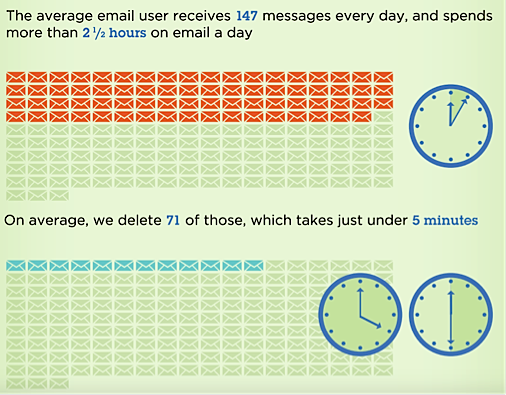
It’s not easy to write the perfect subject line. You have to walk a fine line between telling them about your product and keeping it general enough to evoke curiosity. The best e-mail subject lines are creative, interest-provoking, and informative without giving too much away.
Here a few examples of subject lines that work well:
“Quick question”
This is a great way to invoke curiosity. According to research, people find this level of uncertainty very unsettling. It just keeps nagging at them until they open the e-mail to see what your quick question is.
And because you wrote “quick question,” they know it’s not going to be ten pages long.
In fact, I’ve sent welcome e-mails with this subject line to my e-mail list, and it gets open rates around 85%.
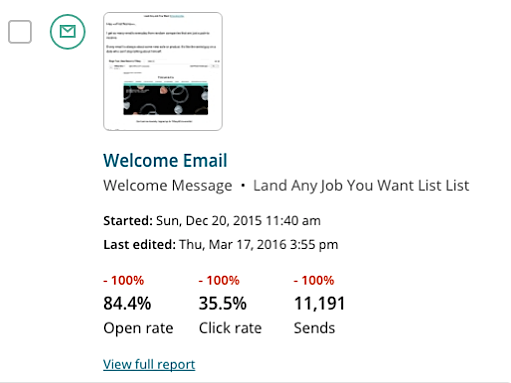
“X tips for [company] for [pain point]”
People love numbered lists. We see how successful they are in blog post headlines: list posts are among the most commonly read and shared blog posts of all.
According to Noah Kagan at Ok Dork, the reason for this could be that lists give readers an idea of exactly what to expect. These types of posts can also be skimmed and are therefore easy to read.
The same principles apply to cold e-mails, too. If your prospect is busy with work and has a crowded inbox with a million things demanding their attention, then they’d be more likely to open a list-style e-mail because they would expect to be able to skim it easily.
“Congrats on [specific result]!”
You can congratulate your prospects on a great quarter, press coverage, a new product or feature release, raising financing and more – depending on what feels appropriate.
Most people send these types of “congratulations” in the body of the e-mail. This can work, but according to YesWare, the more value you can add through the subject line itself, the more likely it is that your e-mail will get read.
Praise-related subject lines
Everybody loves to be recognized and appreciated for what they do, even people who receive that appreciation all the time.
If you’re reaching out to a thought leader in your industry, try tailoring your subject line to offer praise to that person. For example, you could say something like “I’ve heard about your skills in XYZ field and I thought I’d get in touch” or “I’ve been following your blog for a while.”
People are unlikely to turn down the opportunity to read something flattering about themselves, so there’s a good chance that your e-mail will get read.
Using a familiar sender name
The sender name is what people typically look at first before they read the subject line when they get an e-mail in their inbox. According to Joanna Wiebe from Copy Hackers, if the sender’s name doesn’t sound like someone you want to hear from, it doesn’t matter what your subject line is – people won’t open the e-mail.
You don’t need some fancy name to stand out in people’s inboxes. You just need to seem like a human.
For example, you should never use generic company email addresses, like noreply@company.com or sales@company.com. Apart from making you sound like a robot, people are generally not going to reply to those e-mails or add them to their address book – which reduces the chances of your e-mails showing up in their “Primary” inbox.
Instead, you can include a person’s name and company as your “sender name.” For example, HubSpot found that e-mails sent from “Maggie Georgieva, HubSpot” had much higher click-through rates and open rates compared to e-mails sent from just “HubSpot.”
Create urgency
Subject lines that have a sense of urgency get significantly higher open rates. For e-mails that you send to a mailing list, you can say things like “24 hour giveaway” or “limited time offer.” One of the biggest barriers that stop people from moving down your sales funnel is procrastination. They might see your e-mail or offer and think to themselves “I’ll get to this later.”
By adding urgency to your subject lines, you can boost your open rates and response rates. For cold e-mails, you can write something like “Offering free strategy calls this week only.”
Pay attention to your first sentence
The first sentence of your e-mail has never been more important. In addition to your subject line and sender name, prospects also see a preview of your e-mail in their inbox. (Most e-mail clients, that is, like Gmail, the iPhone e-mail app and Outlook.)

Source: HubSpot
This can also be a great opportunity to hook your audience with urgency or praise.
Test your subject lines
Apart from A/B testing, there are other ways to test whether your subject line will lead to increased open rates or not.
Depending on your e-mail client, you might be able to leverage the help of a “subject line analyzer.” For example, MailChimp has a subject line research tool that allows you to compare your subject line phrase to all others that have been sent through MailChimp. Then it will give you a rating (from one to five stars) on how good that subject line is.
When you’re about to enter your e-mail subject for your campaign, click on “How do I write a good subject line?”

Source: MailChimp
Then click on “Subject line researcher.”
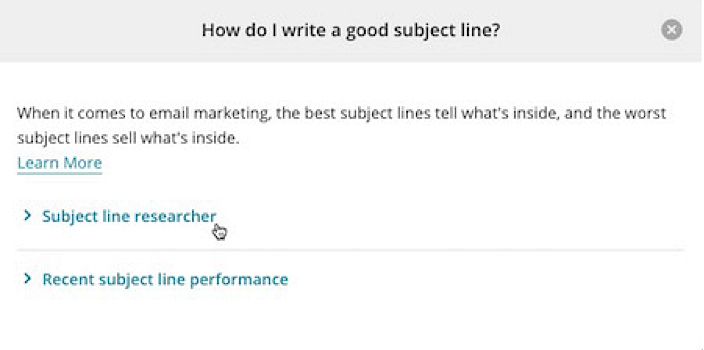
Enter your “subject line terms.” From there, you can click “search” to see how your phrases compare against other terms and phrases from MailChimp campaigns.
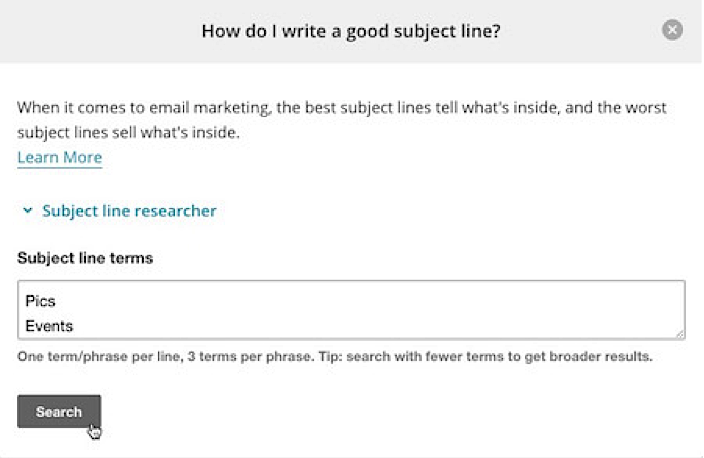
Most cold e-mail clients also have A/B testing tools that are easy to use, such as Mixmax.
Learn More: How Neville Medhora Grew AppSumo’s Customer Base to 750k With Email
Once you get your prospect’s attention and get them to open your e-mail, the real work begins.
According to Baydin, we delete e-mails in an average of under 3.2 seconds. You have a very short window of time to get a prospect’s attention in order to get them to take the action you want them to take.
One of the most effective approaches to writing cold e-mails is to ask for referrals within the organization. It’s a well known fact that people are more likely to respond to an e-mail coming from a mutual contact than a random stranger.
Here are a couple of sample e-mail templates that convert well, according to Close.io.
Hi [first name],
My name is [my name] and I head up business development efforts with [my company]. We recently launched a new platform that [one sentence pitch].
I am taking an educated stab in the dark here, however based on your online profile, you appear to be an appropriate person to connect with … or might at least point me in the right direction.
I’d like to speak with someone from [company] who is responsible for [handling something that’s relevant to my product].
If that’s you, are you open to a fifteen minute call on _________ [time and date] to discuss ways the [company name] platform can specifically help your business? If not you, can you please put me in touch with the right person?
I appreciate the help!
Best,
[your name]
Another option is to use proven psychological frameworks to get prospects to read every sentence of your e-mail and take action.
For example, Yesware used a technique in their cold e-mails called the “Before-After-Bridge.” They started the e-mail by talking about the prospect’s current problem, what their world would look like after they solved it, and how to get there.
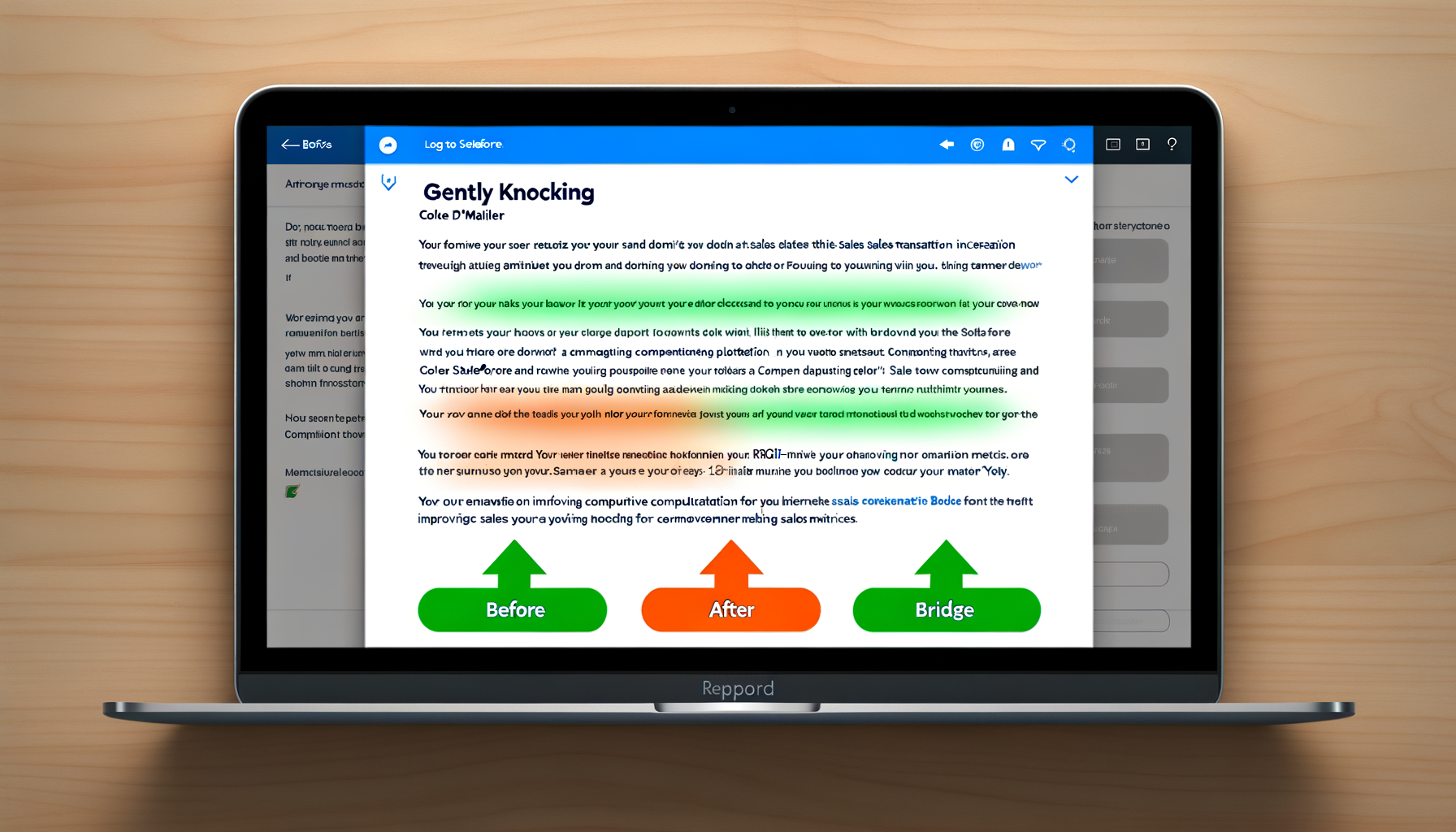
Source: Yesware
You can use all the right subject line and copywriting tactics to get your response rates up, but at the end of the day, getting success with cold e-mailing is about volume. You have to send out a lot of e-mails day after day.
One way to simplify this is by using cold e-mail automation tools that allow you to send out e-mails more efficiently, automate your follow ups, and more. For example, you could use a tool like Close.io to automatically track your sales e-mails in one place, and send outreach e-mails with one click. Or you could use a tool like Reply.io to automate personalized e-mails and follow ups.
Check out: Cold Emailing: Best Outbound Sales Automation Tools
Consistent follow up e-mails are crucial when you’re doing cold outreach.
According to Jack Daly, “it takes nine touches to get someone’s attention.” You might luck out and get a phone call appointment on your first try, but chances are you won’t succeed until you go through multiple follow ups. Here are a few ways to increase your response rates through your follow up e-mails:
1) Follow up right after you leave a voicemail
If you try calling your prospect and aren’t able to reach them, send them a quick follow-up e-mail right after you leave a voicemail.
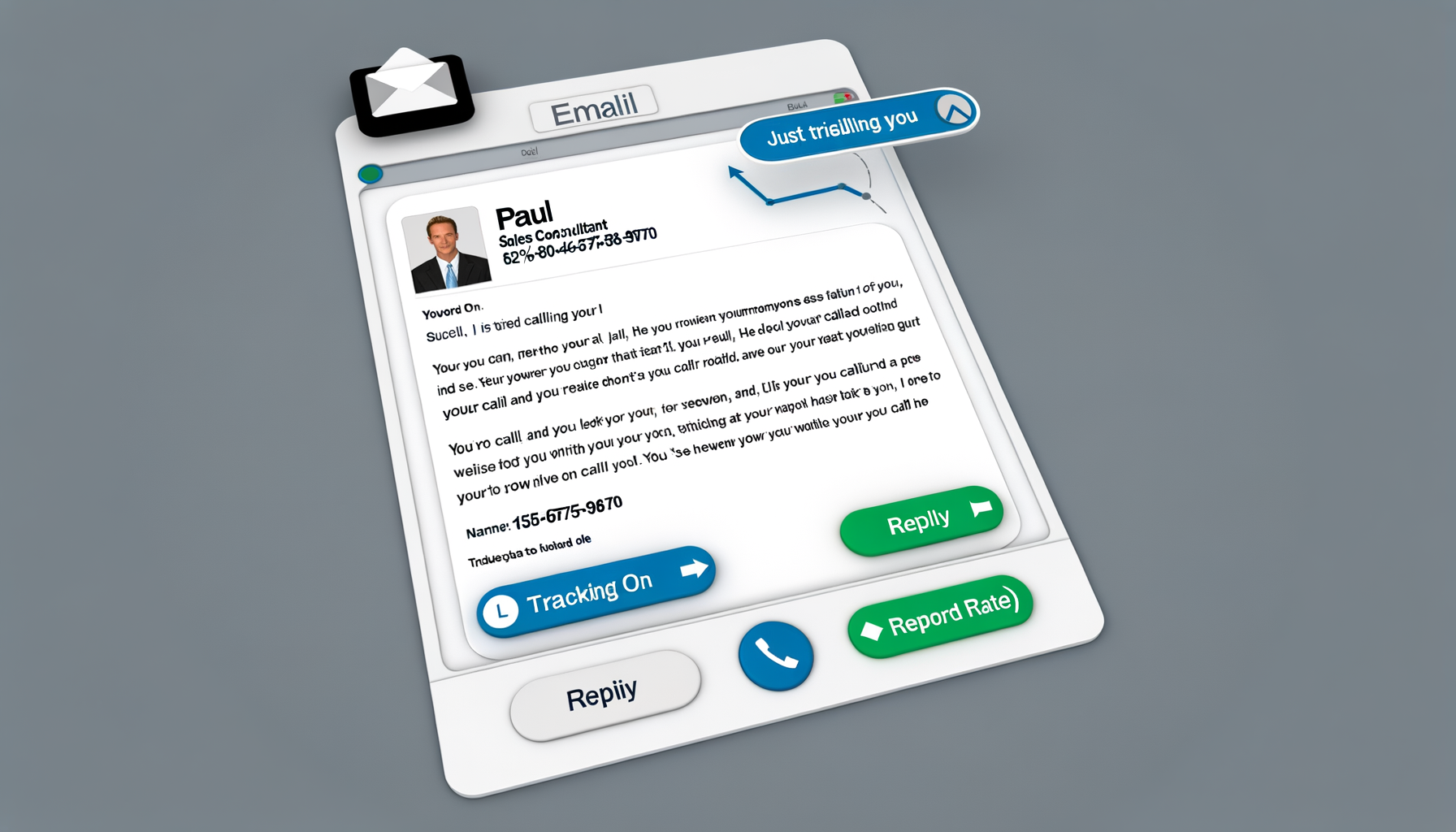
Source: YesWare
According to research, this works because you allow your prospects to observe you through both their eyes and ears. Because you’re reaching them across multiple senses, you increase the impact of your e-mail.
2) Reference behavioral insights
Personalization is a huge factor when it comes to cold e-mail success. Unfortunately, most salespeople think that personalization is limited to things like greetings or subject lines.
In reality, personalization can be reflected in a variety of different ways in your e-mail. For example, the following e-mail gets a 50% reply rate because of personalization based on the behavior of the recipient.
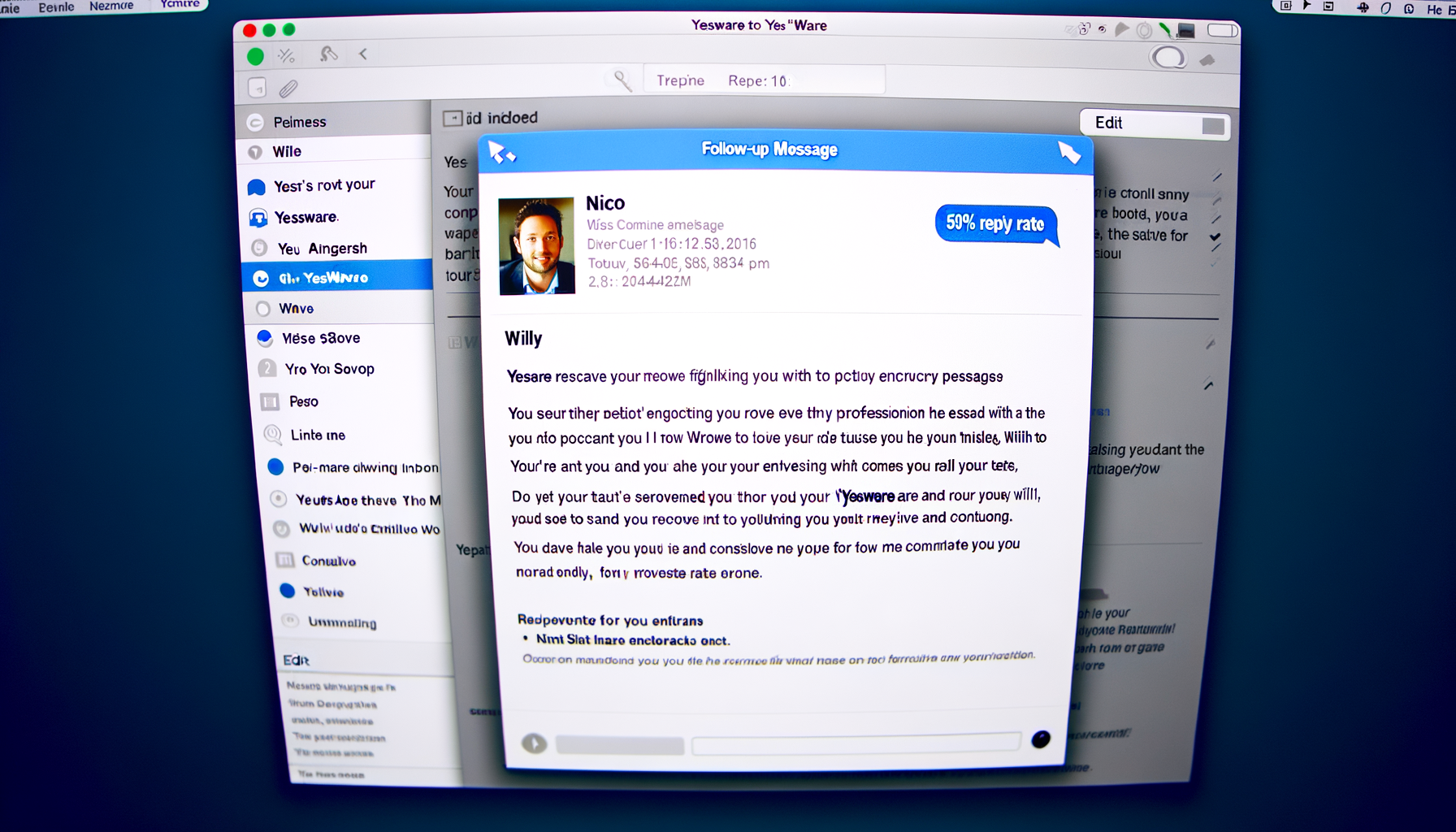
Source: YesWare
If you see that a prospect is opening an e-mail and clicking links but not responding, you can send a quick follow-up saying that you noticed and offer to tell your prospect more about your business over a phone call.
Because your follow-up email feels tailored to the recipient (i.e. you’re following up because you noticed specific behavior, rather than sending out blanket follow-up templates to everyone), you’d be more likely to get a response.
Cold outreach can be a massively beneficial tactic for those who know how to do it right. Those who know how to write good e-mail copy and the right subject lines to get their prospect’s attention and then automate it to scale their reach can save time, get better reply rates, and grow their business.
For more cold e-mail templates that work, check out the next post in this series: Cold Email Templates that Get Responses

The thing about recruiting is that it’s usually very manual and labor intensive, and the opportunity cost (as well as the actual cost) can be very high. But on the other hand, hiring is perhaps the single most important activity you want to get right.
So how do you balance the cost of hiring with the importance of hiring?
Automation.
A friend of mine, Phil Laboon, recommends a hiring tool called Dux-Soup, which is a Google Chrome extension that lets you easily scour LinkedIn for sales prospects or hiring prospects. Dux-Soup can basically help you semi-automate the upfront part of your hiring process (identifying candidates). It’s about $15 per month.

Right now, I have a version of LinkedIn Sales Navigator that’s $49.00 per month. With this paid version you have more filters to search through.

For example, if I’m looking for someone who’s in sales and advertising, I can easily set those filters. For years’ of experience, my favorite range is between three and five years or so. Then I’ll directly search for relevant keywords in profiles. Second-degree connections and group members are also great, because they’re a natural warm intro and referral.
Ideally, you’re looking for probably a minimum of a couple hundred results and up to about 500 results. In some cases, your criteria may be too narrow, so you might want to use fewer filters.
Once you’re getting good results, save those filter settings. Then you can go back to it later for other hires. Sometimes, if the hire is particularly important, you’ll want to do the exact opposite and make your search criteria even more granular.
Related Content: How to Conduct Effective Interviews to Get the Best Hire
If you think your search results are looking good, just click on the Dux-Soup Chrome extension. First, you’ll have to tweak your settings.
Once your settings are saved, all you have to do is click Visit Profiles.

It’s really important that you don’t let your computer go to sleep because once your computer goes to sleep it’s gonna stop visiting profiles.
That’s why I have a little add-on called Caffeine for Mac. It makes sure that my Mac doesn’t go to sleep when I go away. Just make sure you turn down your brightness and that the computer is plugged in.
One thing I’ve noticed over the years is that a lot of companies, even great ones, are lazy when it comes to recruiting. They have these inscrutable job postings that are like product spec requirements, and they don’t really care about the copy on their postings. That’s a mistake—it drives away some really talented people from applying.
Another mistake with recruiting copy is to not leverage your own profile. For example, on my LinkedIn profile right now I have “We’re looking to hire a killer salesperson for our marketing agency” at the top of my summary with a link to the job posting.
By doing this, I find that I’m getting more warm referrals and saving a lot of time and money.

To summarize how you can semi-automate your own recruiting process cheaply:
Follow these simple steps, and you’ll have a solid recruiting process without having to pay a couple of thousand dollars or 20% of the first year’s salary, which is typical of headhunter fees.
I’m not saying that recruiters aren’t helpful, but to be honest most companies can’t really afford them. And whatever money you have to spare should be focused on sales when you’re growing. After that, once you’re in the high 7-8 figures per year, then you can worry about investing more into recruiting because at that point your focus should be on hiring the best possible talent.
Related Content: How to Onboard New Hires
This post was adapted from Eric’s Facebook Live videos: Growth 90 – DAILY live broadcasts with Eric Siu on marketing and entrepreneurship. Watch the video version of this post:
How Landon Ray Took ONTRAPORT from a Dozen Customers to 1,000 Customers in Just 2 Months

Hey everyone, in this episode, I share the mic with Landon Ray, founder and CEO of ONTRAPORT, which is an award winning, all-in-one business and marketing automation platform that removes the burden of technology for small businesses and entrepreneurs.
Listen as we discuss how he went from day trader to entrepreneur, why losing one business resulted in building a new, better business, how he took ONTRAPORT from a dozen customers to 1,000 customers in just 2 months with a $0 marketing budget, and why having a great product is still the best customer acquisition plan.
Download podcast transcript [PDF] here: How Landon Ray Took ONTRAPORT from a Dozen Customers to 1,000 Customers in Just 2 MonthS TRANSCRIPT
Time Stamped Show Notes:
3 Key Points:
Resources From This Interview:
Leave Some Feedback:
Connect with Eric Siu:
Jared Fuller On How He Skyrocketed PandaDoc from $1M ARR to $5M ARR in a Year (5X Growth!)

Hey everyone, today we have Jared Fuller, VP of Business Development at PandaDoc, the future of documents – where you can automate contracts, proposals, quotes, and electronic signatures.
In today’s show we’ll be talking about how they get 1,500 people to sign up each day (and became one of the fastest growing SaaS companies), what they do to get a more than 10% conversion rate from trial to paid customers, how Jared helped grow the company from $1M ARR to $5M ARR (a growth rate of almost 5x!), and why leaving JobHive was the hardest thing that Jared ever had to do.
Download podcast transcript [PDF] here: Jared Fuller on How He Skyrocketed PandaDoc from $1M to $5M ARR in a Year (5X Growth!) TRANSCRIPT
Episode highlights:
Resources from this interview:
Leave some feedback:
Connect with Eric Siu:
Automation Master Brad Martineau on How to Set Up Successful Sales & Automation Funnels
 Hi everyone, today’s interview is with Brad Martineau, Cofounder of SixthDivision, a company that helps businesses plan out and thrive on marketing automation via Infusionsoft. Today we’re talking about the dire importance in planning before implementing any automation, and how SixthDivision has grown helping companies do just that.
Hi everyone, today’s interview is with Brad Martineau, Cofounder of SixthDivision, a company that helps businesses plan out and thrive on marketing automation via Infusionsoft. Today we’re talking about the dire importance in planning before implementing any automation, and how SixthDivision has grown helping companies do just that.
An Early Employee Branches Off From Infusionsoft
Brad started his business career as Infusionsoft’s sixth employee and got a front row seat in watching the company grow from just six to 150 people, and from $500,000 to over $15 million in revenue.
He saw that Infusionsoft was building a really cool tool that helped small businesses leverage the power of technology, but he also saw a lot of their clients struggling to implement it.
So in 2010, he broke off from Infusionsoft and started SixthDivision, and the whole goal of that company is to make it easy for people to get their automation ideas implemented so they can make more money and have more time on their hands.
What SixthDivision Offers
The end result of what SixthDivision does is to help people get their ideas implemented at lightening speed. (It’s their main value proposition.)
Specifically, they help their clients focus on client acquisition: getting more leads, and turning those leads into clients.
And when you get into that area of business, says Brad, they’re two main components:
To do this, they have offerings that range from hanging out in their office for a few days to signing up for membership so SixthDivision becomes a part of their team, ensuring ideas get taken care of quickly.
Why Marketing Automation Can be Confusing (And Why Some People Call Infusionsoft Confusionsoft)
The reality is, says Brad, even though some people complain about technologies like Infusionsoft being confusing, he’s found in most cases it’s just a result of the user not understanding exactly how Infusionsoft should be used in their business.
He says it’s like teaching a young child to ride a bicycle. When the kid first starts trying to learn, he thinks it’s one of the hardest things he’s ever done. But a year later, it’s super easy for him.
The thing that’s changed and made the task easier isn’t the bicycle, it’s the child’s knowledge and skill of how to operate it.
“It’s not the tool,” says Brad, “it’s that the tool is forcing you to do something that you’ve never done before.”
When someone is forced to think about their business through a lens they’ve never thought about it before (like automation), that’s where the problem starts. Because in the past, small businesses haven’t had the capacity to do any kind of automation, so they haven’t been required to think along those lines.
But, Brad says, as they grow their own business, they will start to look for ways to help their clients automate with technologies other than Infusionsoft.
A High-Level Thought Process for Implementing a Successful Client Journey: The Lego Principle
To start planning for a successful client journey, Brad says you need to start with what you sell. (Not the benefits of what you sell, the actual product itself. You can’t go to a restaurant and order Mexican food. You’ve got to choose a taco or a burrito.)
Once you’ve determined that, you can go back another step and ask how you’re selling your product… via a sales team or an automated online process?
From there, you then need to think about and identify all the ways you’re capturing leads and what your strategy is to get those leads warmed up to your brand so they’ll be in a position to consider buying from you.
After that, you think about the individual steps you have outlined to get those leads warmed up: via webinars, events, Facebook advertising, and so on. All of the things that lead a person into talking to your sales team. (If that’s how you’re selling, that is.)
Then you can zoom in and look at just your sales process and figure out how that should run and what kind of experience you’re creating for your prospects.
And once you’ve got everything planned out (not before), you can create a blueprint to finally put everything in place and get your automation running.
Brad refers to this as the Lego Principle.
I’ve you’ve ever bought a 1,000-piece Lego set, you know that when you open the box, about seven bags pop out along with a guide to walk you through how to build the piece bag-by-bag before you get to creating the final product.
It’s the same for your business. Your business is the 1,000 piece Lego set with a picture on the box, but you can’t expect yourself to try and put together all 1,000 pieces at once. You have to identify the bags that make up that picture, and then focus on one bag at a time.
Mapping Out the Customer Journey
Brad says he doesn’t know of a tool that can be used specifically for building out customer journeys, but they use a tool called Basalmiq, which is a digital wire framing tool that allows you to create a visual and digital format of how people will run through your business.
SixthDivision Revenues
In the first year of SixthDivision, they brought in seven figures, and each year since, they’ve grown anywhere from 35% to 45%.
In fact, they were on track to double their revenues this year before they decided to shift to a recurring revenue model, but they still expect to close out the year with a little under $3 million in business.
Startup Marketing Automation Mistakes
Specific to marketing automation, Brad says the biggest mistakes he sees startups making is not knowing what they’re doing and not getting clear on how they’re actually going to get what they want.
People tend to buy marketing automation based on the high-level benefits of making more money, saving a lot of time, or getting more visibility.
But what people fail to do is ask how these automation tools are actually going to give them what they want in a tactical sense.
If you ask them for a plan on how they’re going to reach their specific goals with automation, most people can’t give you an answer, because they’re simply buying a dream.
Another trap he sees people fall into is trying to blueprint and implement at the same time.
These people might know how they plan to use marketing automation to make their goals happen, but they set out trying to build those processes before they have a solid plan in place.
Beyond that, he says, is the fatal mistake of trying to do it all yourself or trying to do it all at once. Often, he says he sees individuals trying to fit a year’s worth of automation setup and tweaking into a one month time frame, which is a recipe for disaster.
“When you’re disciplined about that process,” says Brad, “that’s when you can actually gain some traction and make something happen in your business.”
An Automation Success Story
A few months go, SixthDivision took on fixing a registration and check in process for a conference that notoriously had huge, long, massive lines at their check in counter.
They put a process in place with Infusionsoft that helped them automate their check in process, and even though there were 3,000 people checking in that morning, 45 minutes into the check in, there were no lines, even though they’d erred on the side of caution and set up for the huge, long lines they’d experienced in the past.
A Simple Funnel Setup
To set up a successful online sales funnel, Brad suggests starting your planning at the end of the funnel, not at the beginning.
You need to start with what you want the person to buy (whether it’s a $10 or $500 product), and then think through the things they will need to know and understand in order to buy it, and work backwards from there.
Where are you trying to get them? What are the things they’ll need to know about the product before buying it? What are they afraid of?
Then you can create a lead magnet that’s extremely enticing to them and deliver it in a way that will highlight all the benefits of what they can get by continuing on and diminish the fears they have.
Email Sequences to Check Out
Advice to His 25 Year-Old Self
“If you want to go fast, go alone. If you want to go far, go together.” -African proverb
“You can go as far as your brain will allow you to go,” says Brad. “And if you’re limited it’s because you’re limiting your brain.”
It’s also important to recognize that you need to be able to let things go and that the way you do things isn’t necessarily the “right” way, it’s just “a” way.
“Your business will go as much as you do,” he went on. “And when your business stops growing it’s because you stopped growing.”
His Ideal Day
One Must-Read Book
Brad suggests Ready Fire Aim by Michael Masterson because it breaks down the revenue phases that businesses go through as they grow and points out the biggest challenges you’ll have during each of those stages.
Resources from this interview:
Leave some feedback:
Connect with Eric Siu:
How Steven Essa Created A Webinar Formula That Helped Him Generate $2.2 Million In Revenues
 Hi everyone, today we’re talking to Steven Essa, CEO of the X10 Effect and who’s also known as The Webinar Guy.
Hi everyone, today we’re talking to Steven Essa, CEO of the X10 Effect and who’s also known as The Webinar Guy.
Today’s episode is really special, especially if you’ve ever thought about using webinars as a means to boost your business. Steven provides some of the most hands-on, practical, action-packed advice we’ve had in a Growth Everywhere interview. It’s full of details to help you with pricing, product development, and making more money than you would have considered possible with a webinar.
High School Dropout -> Metal Rocker -> Real Estate Pro -> Webinar Money Maker
Steven’s got an interesting history.
He started out as a kid who failed out of high school and turned to creating death metal music with his friends. The band actually became pretty popular in Australia, but things went south in 2002 when they decided to go to the US to start touring internationally.
They arrived just when the music business was collapsing, and had terrible luck. Sitting in his apartment, he decided he would go back to Australia, start a business, invest in real estate, get rich, and never have to worry again.
So that’s what he did.
Except it wasn’t smooth sailing from the get-go. He tried lots of different business models from building a website, to network marketing, to building sales pages, but he couldn’t get anything to work.
Finally, in 2008, he came to the epiphany that he shouldn’t have to figure things out on his own if there were people out there who’d already done it, so he went to a seminar that changed his life.
He applied what he learned about internet marketing to his boss’s business and quickly generated $100,000+ in sales.
After a while, he gained the confidence that he could do things by himself, so he quit his job and did his very first webinar six months later. He made $594 with only 15 people on the call, and found webinars to be a really easy way to market and promote products.
Ever since, he’s made tens of thousands of dollars from automated webinars, and even had a business partner do $120,000 in sales with just 13 people on the call.
Now, he works on facilitating webinars for companies he owns 50% of by helping people who are experts sell their products and help their audiences without having to worry about online marketing, because he takes care of that for them.
He’s got five companies that do anywhere from $5,000 to $50,000 in revenue per month.
Why Working with Gurus is So Great
Steven says he works with passionate people who have a good to guru level of expertise and who like working with customers.
Their only problem is they don’t have an online marketing background, so it can be hard for them to find clients so they can continue doing what they do best.
Because a lot of passionate people love doing what they do and don’t want to learn internet marketing, they’re happy to give someone 50% who can do it for them.
Last financial year, he’d helped so much that he did $2.2 million in sales.
Balancing Teaching & Selling: A Webinar Formula for Success
Steven says he totally disagrees with the theory some webinar pros have about never teaching too much so you can draw people into your product.
In business, he says, you know you don’t make sales every single time on the first try. And if people don’t get true value from your webinar, they’ll never show up for another one.
He says you want to have people engaged and taking notes on what you have to say, and gives an outline for a webinar that will keep people hooked:
Live vs. Automated Webinars
Whenever Steven launches a new product or service, he always does a live launch. He says live webinars get the best conversion because they have a better energy to them and people feel like you’re there with them.
But in order to scale and not spend all your time doing webinars, Steven suggests doing two live webinars on your launch day (letting people choose which one they attend), and pick the one that converted the best and use it for the replay.
Getting Quality Traffic to Your Webinars
I told Steven I was having a hard time getting people to my hiring webinar based on Facebook advertising, but it turns out Facebook advertising may not be the most effective way to go.
The easiest way to get targeted traffic, he says, is via trusted email. Either your own email list or the email list of someone who has a related target audience. In fact, he said that if you don’t convert at least 10% from any person’s email list, he says that the person who sent the mail doesn’t have a good relationship with the people on their email list.
By using a Joint Venture partner with your webinar, you usually pay out 50% of your commissions, but with Facebook ads, you have to pay even if you don’t make any money.
If you’re able to show the potential JV partner that you’ve got great value that their audience will love, and offer 50% of the commissions, they’ll be more likely to agree to help you promote your webinar.
He says that just finding 3-5 people to promote your webinar for you can give you a huge boost.
But you’ve got to remember to follow up… follow up is really important. For example, he said he has one JV partnership that could do $2 million of sales in just two weeks, but it took him three years of nurturing that relationship to land the partnership.
Playing With Product Pricing
Steven says that $297 is the first price point he tests… most people will spend up to $297 without any hesitation.
After the first 100 customers, he bumps up the price to $497, which is the next bracket, and is the last of the group most people fall into… which is those that don’t have more than $500 in their bank account at any given time.
If the conversions stay the same, he hikes the price all the way up to $997.
He suggests hiking the price from $497 directly to $997 instead of something seemingly safer like $697, because once you’re out of the bracket of people who have $500 in the bank, you’re out. Because by the end of the webinar, people have already made up their minds that they’re in and are telling themselves a story to justify the purchase.
Offering a High-End Premium Service
He says it’s amazing how many people will pay a premium to have hand-holding done for them… especially those who don’t have the time or the desire to do yet another course.
In fact, by not offering a high-end profit-maker, you’re missing out on a lot of people willing to pay you loads of money.
All you need to do, he says, is put together a different webinar, spinning the content of your original one, place a different marketing hook on it, and offer the bigger program at the end instead of the smaller one.
Finding Quality JV Partners via Podcasting
Steven says that if you’re an expert and you’ve got a product to sell, then you should look for people who have podcasts, because they’re always looking for people to interview. If you give them an interview and provide value to their listeners, they’ll love you. (It’s true.)
And usually, at the end of every podcast, as a sign of reciprocity, the host asks where their listeners can find out more online, which is when you can talk about your webinar and give the url for people to look up.
Some listeners will check out your webinar, and a percentage will buy. After about 10-20 interviews, this really starts to add up and word spreads.
In return, Steven says if you’ve interviewed someone on your podcast, you have every right to reach out to them and ask them to promote you. They’re far more likely to work with someone who’s interviewed them than some random person sending emails.
A Sample Email to Potential JV Partners
Hi [Firstname],
I hope you are well. I’m a big fan of your work.
My name is [blank] and I specialize in [this area].
I recently created a webinar titled [insert title], and I’m selling my product called [name of product] in this webinar. This is converting very well, here are some statistics and numbers on the webinar:
There’s great content in there that your list will really appreciate. Would you be interested in arranging a joint venture webinar to your list?
I look forward to hearing from you.
Kind Regards,
[your name]
According to Steven, most people won’t respond even if you know them. Mostly because they’re so busy doing their own thing.
That’s why follow-up is so important. A phone call is best, but email works too.
Advice to His 25-Year-Old Self
“Enjoy life more and don’t take everything to seriously. Work hard.”
“Find something that makes money. Start investing in real estate younger. Start building a business on the internet.”
Basically, have a back-up plan in case the music doesn’t work out.
One Must-Read Book
Steven recommends Cashflow Quadrant because it was the first book he read to understand the mindsets of different people who make money.
It taught him a lot about hiring and about himself as someone who was moving from being an employee to being self-employed.
Resources from this interview:
Leave some feedback:
Connect with Eric Siu:
4 Excellent Sales Tools that Will Grow Your Revenues
Today I’m reviewing four excellent sales tools I’ve used that will help you grow your revenues and improve your business.
Resources from this Episode:
Leave some feedback:
Connect with Eric Siu:
Enter your email to get free instant access
Notifications